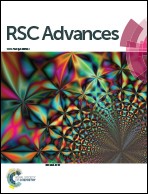Selective removal of transition metal ions from aqueous solution by metal–organic frameworks
Abstract
Water stable Zr-based metal–organic frameworks (MOFs) with different functional groups were used for selective removal of Cu2+ over Ni2+ from aqueous solution. Due to the unique chelation effect of two carboxyl groups on the adjacent organic ligand as well as the Jahn–Teller effect, UiO-66(Zr)–2COOH exhibits the highest selectivity (up to about 27) for Cu2+/Ni2+ in aqueous solution among the reported adsorbents as far as we know. In addition, the removal process is fast with less than 60 min for equilibration, and the stability and regenerability are good. These results may be helpful not only for the efficient treatment of wastewater containing heavy transition metal ions, but also for metal enrichment and recycling.


 Please wait while we load your content...
Please wait while we load your content...